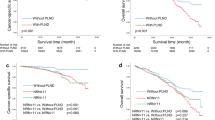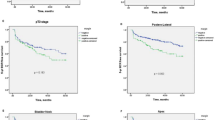Abstract
Background:
The incremental morbidity of lymph node dissection (LND) among men undergoing radical prostatectomy remains uncertain. We therefore evaluated the association of LND with perioperative morbidity among men undergoing minimally invasive radical prostatectomy (MIRP).
Methods:
We identified 29,012 men aged 35–89 who underwent MIRP from 2010–2015 in the National Surgical Quality Improvement Program (NSQIP) database, of whom 47% underwent concomitant LND. The associations of LND with 30-day perioperative morbidity and mortality were evaluated using logistic regression, adjusted for patient features.
Results:
Median age at surgery was 63 (IQR 57, 67) years. There were statistically significant, but clinically insignificant, differences in several baseline characteristics stratified by performance of LND, including older age at surgery (p < 0.001), higher American Society of Anesthesiology (ASA) class (p < 0.001), and longer operative time (p < 0.001) for men who underwent LND. Overall, 30-day complications occurred in 4.3% of patients. There were no statistically significant differences in rates of 30-day complications (4.2 vs. 4.4%, p = 0.44), perioperative blood transfusion (1.7 vs. 1.7%, p = 0.99), hospital readmission (3.6 vs. 4.0%, p = 0.09), reoperation (1.1 vs. 1.1%, p = 0.80), or 30-day mortality (0.1 vs. 0.2%, p = 0.56) between patients who underwent MIRP alone or MIRP with LND, respectively. On multivariable analysis, LND was not significantly associated with an increased risk of perioperative morbidity or 30-day mortality.
Conclusions:
LND at the time of MIRP does not appear to be associated with an increased risk of perioperative morbidity.
This is a preview of subscription content, access via your institution
Access options
Subscribe to this journal
Receive 4 print issues and online access
$259.00 per year
only $64.75 per issue
Buy this article
- Purchase on Springer Link
- Instant access to full article PDF
Prices may be subject to local taxes which are calculated during checkout

Similar content being viewed by others
References
Sanda M, et al. Clinically Localized Prostate Cancer: AUA/ASTRO/SUO guideline. part I: risk stratification, shared decision making, and care options. J Urol. 2017 Dec 15. pii: S0022-5347(17)78003-2. doi: 10.1016/j.juro.2017.11.095. [Epub ahead of print].
Mottet N, et al. EAU-ESTRO-SIOG guidelines on prostate cancer. part 1: screening, diagnosis, and local treatment with curative intent. Eur Urol. 2017;71:618–29.
Mohler JL, et al. Prostate cancer, version 1.2016. J Natl Compr Canc Netw. 2016;14:19–30.
Touijer KA, et al. Long-term outcomes of patients with lymph node metastasis treated with radical prostatectomy without adjuvant androgen-deprivation therapy. Eur Urol. 2014;65:20–5.
Fossati N, et al. The benefits and harms of different extents of lymph node dissection during radical prostatectomy for prostate cancer: a systematic review. Eur Urol. 2017;72:84–109.
van der Poel HG, et al. Robot-assisted laparoscopic prostatectomy: nodal dissection results during the first 440 cases by two surgeons. J Endourol. 2012;26:1618–24.
Keegan KA, Cookson MS. Complications of pelvic lymph node dissection for prostate cancer. Curr Urol Rep. 2011;12:203–8.
Wang EH, et al. Variation in pelvic lymph node dissection among patients undergoing radical prostatectomy by hospital characteristics and surgical approach: results from the National Cancer Database. J Urol. 2015;193:820–5.
Grande P, et al. Prospective randomized trial comparing titanium clips to bipolar coagulation in sealing lymphatic vessels during pelvic lymph node dissection at the time of robot-assisted radical prostatectomy. Eur Urol. 2017;71:155–8.
American College of Surgeons (ACS). NSQIP participant use data file. https://www.facs.org/quality-programs/acs-nsqip/participant-use. Accessed 3/07/2018.
Gandaglia G, et al. Robot-assisted radical prostatectomy and extended pelvic lymph node dissection in patients with locally-advanced prostate cancer. Eur Urol. 2017;71:249–56.
Briganti A, et al. Pelvic lymph node dissection in prostate cancer. Eur Urol. 2009;55:1251–65.
Harbin AC, Eun DD. The role of extended pelvic lymphadenectomy with radical prostatectomy for high-risk prostate cancer. Urol Oncol. 2015;33:208–16.
Choo MS, et al. Extended versus standard pelvic lymph node dissection in radical prostatectomy on oncological and functional outcomes: a systematic review and meta-analysis. Ann Surg Oncol. 2017;24:2047–54.
Briganti A, et al. Complications and other surgical outcomes associated with extended pelvic lymphadenectomy in men with localized prostate cancer. Eur Urol. 2006;50:1006–13.
Musch M, et al. Complications of pelvic lymphadenectomy in 1,380 patients undergoing radical retropubic prostatectomy between 1993 and 2006. J Urol. 2008;179:923–8. discussion 928-9
Tewari A, et al. Positive surgical margin and perioperative complication rates of primary surgical treatments for prostate cancer: a systematic review and meta-analysis comparing retropubic, laparoscopic, and robotic prostatectomy. Eur Urol. 2012;62:1–15.
Novara G, et al. Systematic review and meta-analysis of perioperative outcomes and complications after robot-assisted radical prostatectomy. Eur Urol. 2012;62:431–52.
Ploussard G, et al. Pelvic lymph node dissection during robot-assisted radical prostatectomy: efficacy, limitations, and complications-a systematic review of the literature. Eur Urol. 2014;65:7–16.
Liss MA, et al. Outcomes and complications of pelvic lymph node dissection during robotic-assisted radical prostatectomy. World J Urol. 2013;31:481–8.
Lindberg C, et al. Extended pelvic lymphadenectomy for prostate cancer: will the previously reported benefits be reproduced in hospitals with lower surgical volumes? Scand J Urol Nephrol. 2009;43:437–41.
Augustin H, et al. Intraoperative and perioperative morbidity of contemporary radical retropubic prostatectomy in a consecutive series of 1243 patients: results of a single center between 1999 and 2002. Eur Urol. 2003;43:113–8.
Eifler JB, et al. Pelvic lymph node dissection is associated with symptomatic venous thromboembolism risk during laparoscopic radical prostatectomy. J Urol. 2011;185:1661–5.
Tollefson MK, et al. Blood type, lymphadenectomy and blood transfusion predict venous thromboembolic events following radical prostatectomy with pelvic lymphadenectomy. J Urol. 2014;191:646–51.
Spring DB, et al. Ultrasonic evaluation of lymphocele formation after staging lymphadenectomy for prostatic carcinoma. Radiology. 1981;141:479–83.
Solberg A, et al. Frequency of lymphoceles after open and laparoscopic pelvic lymph node dissection in patients with prostate cancer. Scand J Urol Nephrol. 2003;37:218–21.
Orvieto MA, et al. Incidence of lymphoceles after robot-assisted pelvic lymph node dissection. BJU Int. 2011;108:1185–90.
Musser JE, et al. Impact of routine use of surgical drains on incidence of complications with robot-assisted radical prostatectomy. J Endourol. 2014;28:1333–7.
Lee HJ, Kane CJ. How to minimize lymphoceles and treat clinically symptomatic lymphoceles after radical prostatectomy. Curr Urol Rep. 2014;15:445.
Gilbert DR, Angell J, Abaza R. Evaluation of absorbable hemostatic powder for prevention of lymphoceles following robotic prostatectomy with lymphadenectomy. Urology. 2016;98:75–80.
Acknowledgements
The American College of Surgeons National Surgical Quality Improvement Program and the hospitals participating in the ACS NSQIP are the source of the data used herein; they have not verified and are not responsible for the statistical validity of the data analysis or the conclusions derived by the authors.
Author information
Authors and Affiliations
Corresponding author
Ethics declarations
Conflict of interest
The authors declare that they have no conflict of interest.
Electronic supplementary material
Rights and permissions
About this article
Cite this article
Brito, J., Pereira, J., Moreira, D.M. et al. The association of lymph node dissection with 30-day perioperative morbidity among men undergoing minimally invasive radical prostatectomy: analysis of the National Surgical Quality Improvement Program (NSQIP). Prostate Cancer Prostatic Dis 21, 245–251 (2018). https://doi.org/10.1038/s41391-018-0051-z
Received:
Revised:
Accepted:
Published:
Issue Date:
DOI: https://doi.org/10.1038/s41391-018-0051-z
This article is cited by
-
Severe intraoperative bleeding predicts the risk of perioperative blood transfusion after robot-assisted radical prostatectomy
Journal of Robotic Surgery (2022)
-
The impact of extended pelvic lymph node dissection on the risk of hospital readmission within 180 days after robot assisted radical prostatectomy
World Journal of Urology (2020)
-
The ongoing dilemma in pelvic lymph node dissection during radical prostatectomy: who should decide and in which patients?
Journal of Robotic Surgery (2020)



